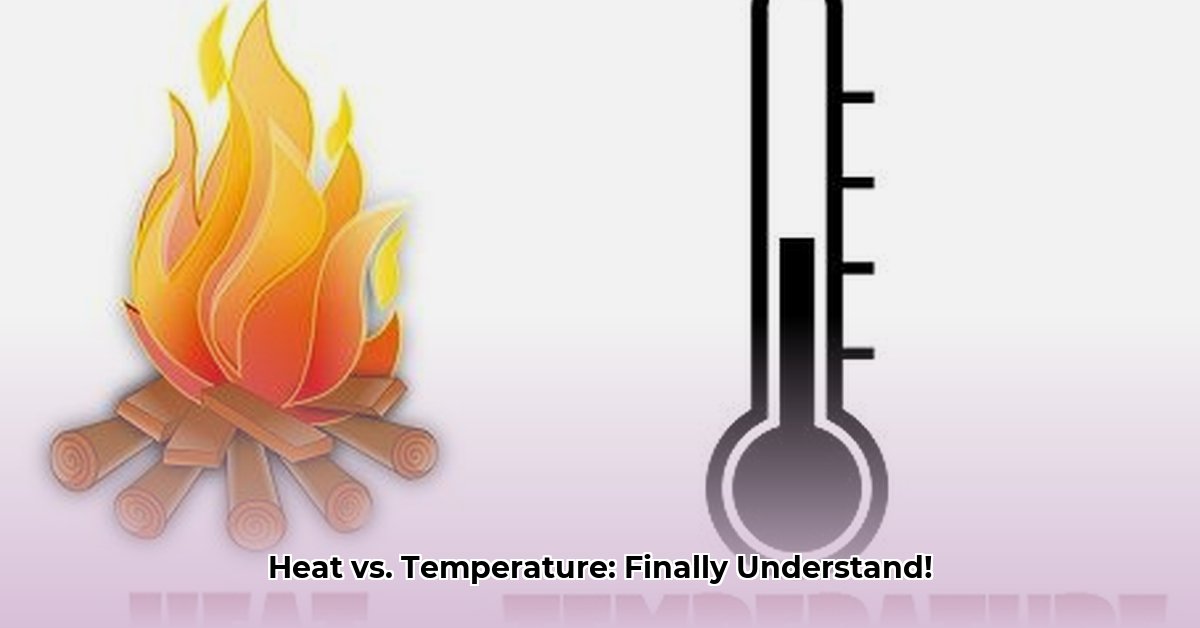Heat and temperature are often used interchangeably, but understanding their distinct meanings is crucial in various scientific and everyday applications. This guide clarifies the difference between these two fundamental concepts, exploring their relationship and practical implications. Why does a large, cool lake hold more heat than a small, hot cup of coffee? For more on temperature conversions, see this helpful guide: Fahrenheit to Celsius. Let’s delve into the world of thermodynamics and find out.
Decoding the Thermal Duo: Heat vs. Temperature
Heat and temperature are interconnected yet distinct, like two sides of the same coin. Grasping this difference unlocks a deeper understanding of the world around us, from weather patterns to cooking techniques.
Temperature: Measuring the Average Kinetic Energy
Temperature quantifies the average kinetic energy of particles within a substance. Picture a group of dancers: temperature gauges their average energy level. Are they swaying gently or vigorously moving? A higher temperature signifies that the particles, on average, move faster and possess greater kinetic energy. In boiling water, the molecules are highly energetic, while in a block of ice, they move much more slowly. Temperature is typically measured in degrees Celsius (°C), Fahrenheit (°F), or Kelvin (K).
Heat: The Total Thermal Energy
Heat, on the other hand, represents the total thermal energy within a system. It’s the combined energy of all the dancers, not just their individual energy levels. A large, cool lake can hold more total heat than a small, steaming cup of coffee, even if the coffee has a higher temperature. This is because the lake contains a vast number of water molecules, each contributing to the overall heat content, even at slower speeds. Heat is measured in Joules (J) or calories (cal), which are units of energy.
The Interplay: Heat Transfer and Equilibrium
Temperature and heat are intrinsically linked. A substance with a higher temperature generally possesses more energetic particles, and a larger quantity of energetic particles translates to greater heat content. When an ice cube is dropped into warm water, heat flows from the warmer water (higher temperature) to the cooler ice cube (lower temperature). This transfer continues until thermal equilibrium is reached—when both the water and the ice reach the same temperature. Heat always flows from areas of higher temperature to areas of lower temperature, striving for balance.
Practical Applications: From Engineering to Everyday Life
Understanding the difference between heat and temperature is essential for accurate measurements and practical applications. Engineers design heating and cooling systems by considering both the desired temperature and the total heat energy required. Material scientists choose materials based on their thermal properties, such as thermal conductivity and heat capacity. We also intuitively use this knowledge in everyday life, from wearing warm clothes in winter to using refrigerators to keep food cool.
Latent Heat: The Hidden Energy in Phase Transitions
The relationship between heat and temperature becomes more nuanced during phase transitions, such as melting or boiling. When ice melts, it absorbs heat, but its temperature remains constant at 0°C (32°F) until all the ice has transformed into liquid water. This absorbed heat, known as latent heat, is the energy required to change a substance’s state (solid, liquid, gas) without altering its temperature. During a phase transition, the temperature remains constant while the substance absorbs or releases energy.
Comparing Heat and Temperature: A Summary
| Feature | Heat | Temperature |
|---|---|---|
| Definition | Total thermal energy of a system | Average kinetic energy of particles |
| Measurement | Joules (J), calories (cal) | Celsius (°C), Fahrenheit (°F), Kelvin (K) |
| Transfer | Flows from hot to cold | Determines the direction of heat flow |
| Effect | Changes the overall energy of a system | Indicates the average particle kinetic energy |
| Phase Change | Involved in latent heat during transitions | Remains constant during phase transitions |
Exploring the Frontiers of Thermodynamics
Our understanding of heat and temperature is constantly evolving. Ongoing research delves into extreme environments and novel materials, further refining our knowledge. This understanding has far-reaching implications, ranging from addressing climate change to developing advanced technologies. The exploration of thermodynamics continues, with many mysteries yet to be unraveled. Perhaps you’ll be the next to make a groundbreaking discovery in this fascinating field.
- Find Trinidad and Tobago Time: UTC-4, No DST Explained - June 17, 2025
- Find what time is it in gambia africa: Updated Time & Insights - June 17, 2025
- Unlock Environ Engineering Success: CA Consulting Trends - June 17, 2025
















